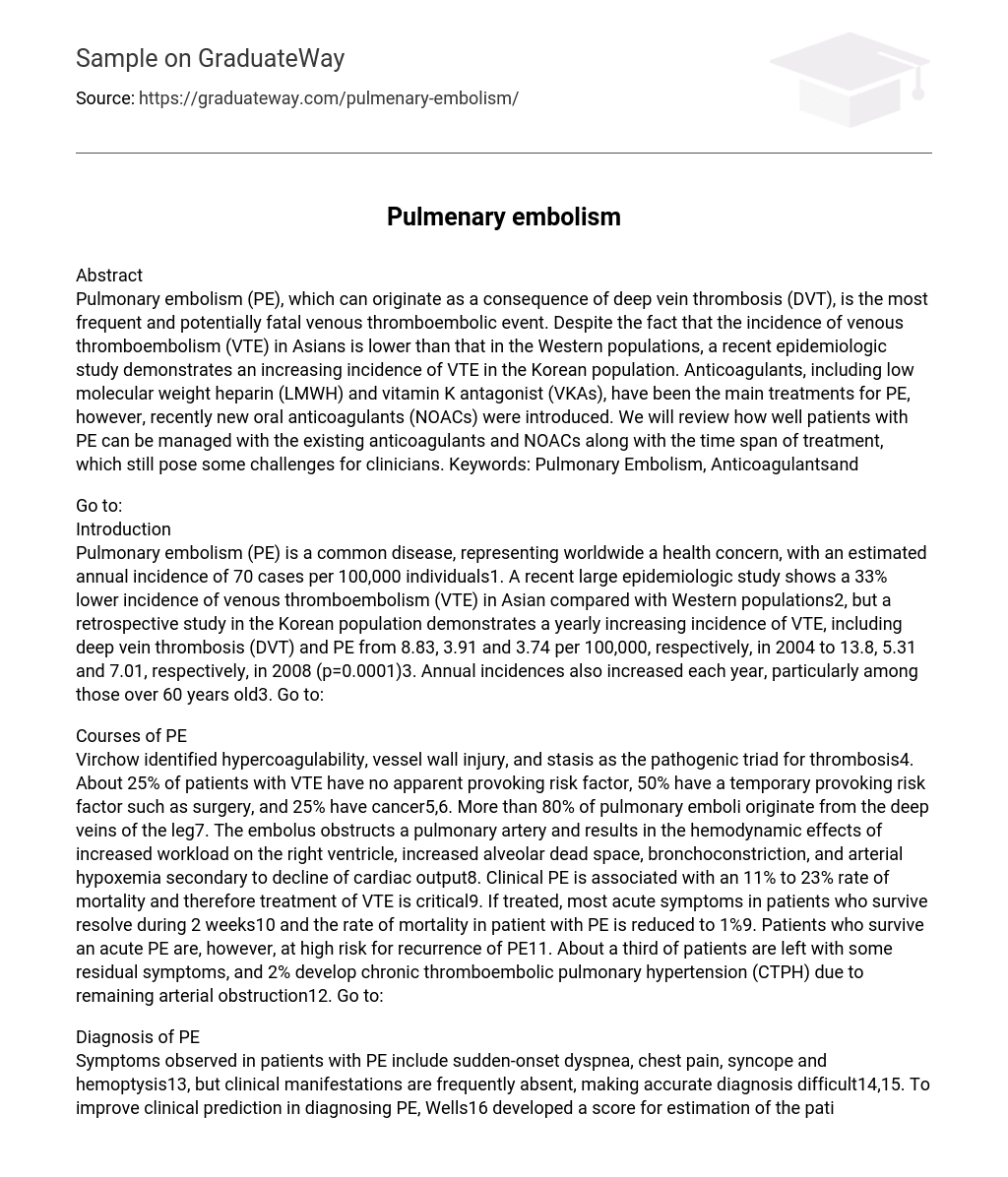Abstract
Pulmonary embolism (PE), which can originate as a consequence of deep vein thrombosis (DVT), is the most frequent and potentially fatal venous thromboembolic event. Despite the fact that the incidence of venous thromboembolism (VTE) in Asians is lower than that in the Western populations, a recent epidemiologic study demonstrates an increasing incidence of VTE in the Korean population. Anticoagulants, including low molecular weight heparin (LMWH) and vitamin K antagonist (VKAs), have been the main treatments for PE, however, recently new oral anticoagulants (NOACs) were introduced. We will review how well patients with PE can be managed with the existing anticoagulants and NOACs along with the time span of treatment, which still pose some challenges for clinicians. Keywords: Pulmonary Embolism, Anticoagulantsand
Go to:
Introduction
Pulmonary embolism (PE) is a common disease, representing worldwide a health concern, with an estimated annual incidence of 70 cases per 100,000 individuals1. A recent large epidemiologic study shows a 33% lower incidence of venous thromboembolism (VTE) in Asian compared with Western populations2, but a retrospective study in the Korean population demonstrates a yearly increasing incidence of VTE, including deep vein thrombosis (DVT) and PE from 8.83, 3.91 and 3.74 per 100,000, respectively, in 2004 to 13.8, 5.31 and 7.01, respectively, in 2008 (p=0.0001)3. Annual incidences also increased each year, particularly among those over 60 years old3. Go to:
Courses of PE
Virchow identified hypercoagulability, vessel wall injury, and stasis as the pathogenic triad for thrombosis4. About 25% of patients with VTE have no apparent provoking risk factor, 50% have a temporary provoking risk factor such as surgery, and 25% have cancer5,6. More than 80% of pulmonary emboli originate from the deep veins of the leg7. The embolus obstructs a pulmonary artery and results in the hemodynamic effects of increased workload on the right ventricle, increased alveolar dead space, bronchoconstriction, and arterial hypoxemia secondary to decline of cardiac output8. Clinical PE is associated with an 11% to 23% rate of mortality and therefore treatment of VTE is critical9. If treated, most acute symptoms in patients who survive resolve during 2 weeks10 and the rate of mortality in patient with PE is reduced to 1%9. Patients who survive an acute PE are, however, at high risk for recurrence of PE11. About a third of patients are left with some residual symptoms, and 2% develop chronic thromboembolic pulmonary hypertension (CTPH) due to remaining arterial obstruction12. Go to:
Diagnosis of PE
Symptoms observed in patients with PE include sudden-onset dyspnea, chest pain, syncope and hemoptysis13, but clinical manifestations are frequently absent, making accurate diagnosis difficult14,15. To improve clinical prediction in diagnosing PE, Wells16 developed a score for estimation of the patient’s risk of PE17. There are several imaging tests to diagnose PE, including ventilation and perfusion scans, spiral computed tomography (CT), and pulmonary angiography. Spiral CT has been shown to be superior to ventilation and perfusion scan for detection and exclusion of PE18. It is safer and more available than pulmonary angiogram, which outlines thrombi in the pulmonary arteries with intravenous (IV) contrast medium. The patient’s presentation should be correlated with the CT scan. If the data coincide with the CT scan, then clinical decision can be made with the CT scan, otherwise additional testing may be indicated19.
The widespread use of CT increased the diagnosis of incidental pulmonary embolism, which was reported in 2.6% in a meta-analysis20. D-dimer is formed when cross-linked fibrin is broken down by plasmin. Levels are almost always increased in VTE21,22. A negative D-dimer can be used for exclusion of PE when the onset of symptoms is very recent (that is, it has a high negative predictive value)16,17,23. However, a negative D-dimer with rapid enzyme-linked immunosorbent assay does not exclude PE in more than 15% of patients with a high probability clinical assessment24. Because D-dimer levels are commonly increased by other conditions, including age, pregnancy, cancer, trauma, inflammation and recent surgery, an abnormal result has a very low positive predictive value for PE. Go to:
Treatment of PE
Anticoagulants should be administered to patients with PE to prevent fatal outcome and to minimize the risk of recurrent VTE, post-thrombotic syndrome or CTPH14,15. The current treatment approach for acute PE, according to the American College of Chest Physicians (ACCP) 9th guidelines recommendations, consists of initial treatment with parenteral anticoagulation (low molecular weight heparin [LMWH], fondaparinux, IV or subcutaneous [SC] unfractionated heparin [UFH]), overlapped with vitamin K antagonists (VKAs) for at least 5 days until the prothrombin time (PT) has been within the therapeutic range for two days14,25,26. SC LMWH and fondaparinux do not require IV infusion or laboratory monitoring, whereas IV UFH is preferred if there is shock, severe renal impairment (LMWH and fondaparinux are renally excreted), thrombolytic therapy is being considered, or it may be necessary to reverse anticoagulation rapidly
2. For long-term treatment of PE, the use of VKAs is recommended for 3 months or longer, depending on whether the PE is attributable to a transient risk factor or is unprovoked14,25. In patients with a high clinical suspicion of acute PE, the guideline suggests treatment with parenteral anticoagulants rather than no treatment while awaiting the results of diagnostic tests. In patients with acute PE treated with LMWH, once-over twice-daily administration is suggested25. Patients with PE may have different pharmacokinetic responses to UFH, with a requirement for larger doses than those used in patients with DVT27. In patients with acute PE associated with hypotension (e.g., systolic blood pressure





